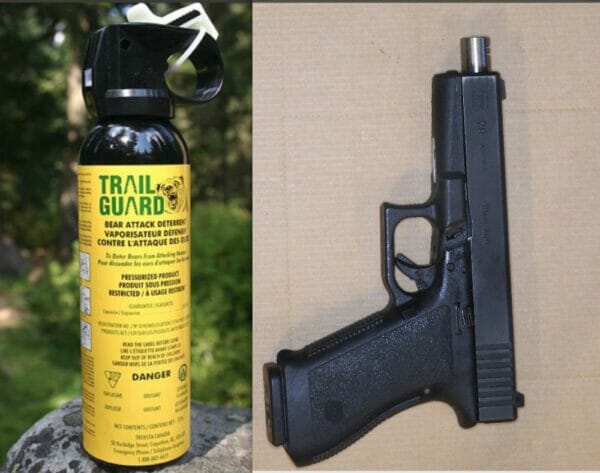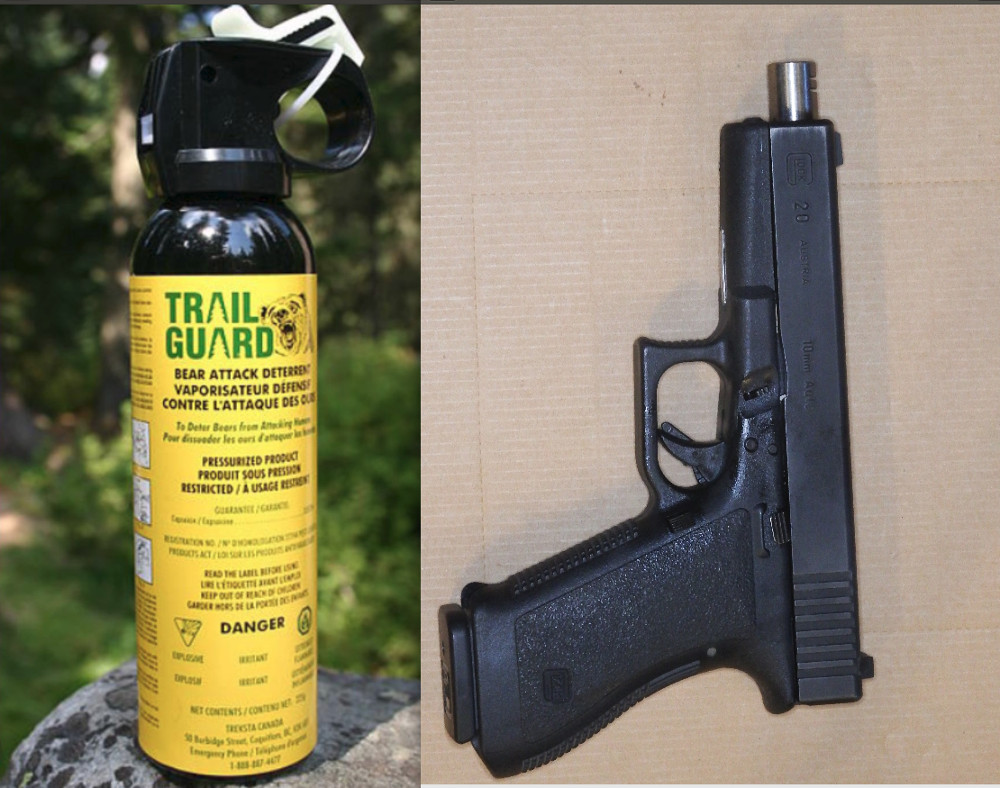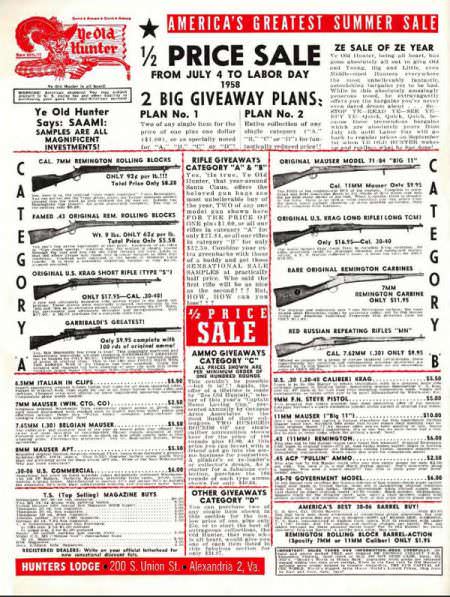
U.S.A. — Seven times as many people have been killed by bears when bear spray has been sprayed in defense than have been killed by bears when a handgun has been fired in defense.
Any comparison of the efficacy of bear spray and firearms is difficult. There are many variables. The data is subject to selection bias. The analysis of the data is subject to confirmation bias. Similar problems exist with the defensive uses of firearms.
Fatal bear attacks are less subject to selection bias because nearly all fatal bear attacks are recorded.
We nearly always know when bear spray was sprayed in a fatal bear attack. We nearly always know when a handgun was fired during a fatal bear attack. This correspondent and colleagues have collected all the incidents where handguns have been fired in defense against bears, which we can document since 1890. We have published records of the 170 documented cases. We had not collected documented records of when bear spray was sprayed in defense against bears.
We cannot objectively compare the efficacy of bear spray to handguns in general because there are many, probably a large majority, of attacks/conflicts that are not documented and will never be documented for both bear spray and handguns.
Failed attempts to defend against bears are much more likely to be recorded than successful defenses.
Failures in defense against bears are news. Most of them are recorded. It is reasonable to assume the vast majority of fatal failures of either handguns or bear spray are recorded.
Since 1890, we have documented one incident where a handgun was fired in defense against a bear, and a person was killed. The incident was in the Svalbard Archipelago in 1995.
The numbers are very small. Very few people are killed by bears in a given year. Bear spray has only been commercially available since 1986. Cartridge handguns have been commercially available since about 1860. Since 1986 there have been seven incidents where bear spray was sprayed in defense against bears, and a person was killed. Here are the seven incidents.
The first incident was in 2003. Vitaly Nikolayenko was killed and partly consumed by a European brown bear (grizzly bear) in Russia after Nikolayenko had sprayed bear spray.
The second incident was when Erin Johnson was killed by a black bear near the Pogo Mine in Alaska after the bear was sprayed with bear spray in 2017.
The third incident was when Mark Uptain was killed by a grizzly bear in Wyoming after spraying bear spray on September 14, 2018.
The fourth incident happened on July 29, 2020, when Daniel Schilling was killed by a bear or bears while clearing a trail near his home in Alaska. Both black bear and grizzly bear DNA was found at the site.
The fifth incident occurred on August 27, 2020, when Curtis Blaise used bear spray on the black bear which was attacking his wife, Stephanie, at McKie Lake in northern Saskatchewan. When the bear spray proved ineffective, Curtis retrieved a rifle and killed the bear, but the bear had already killed Stephanie Blaise. Some might argue the rifle also failed to stop the attack in time. The rifle could not have stopped the fatality, as Stephanie was already dead when the rifle was used. This incident is the least clear of the documented failed bear spray defenses.
The sixth incident occurred on April 15, 2021, when Carl Mock was killed by a grizzly bear near the border of Yellowstone National Park after spraying the bear with bear spray.
The seventh incident happened on July 6, 2021, when Leah Lokan was attacked and killed by a grizzly bear in Ovando, Montana. She was pulled from her tent after using bear spray to defend herself.
Bear spray became commercially available in 1986. The use of bear spray received a boost with the paper on the effectiveness of bear spray by Smith and Herrero in 2008. In a study of 72 incidents where bears were sprayed, 25 involved aggressive bears. The authors judged bear spray to be 92% effective in the 72 incidents. None of the people involved in the incidents were hunting. 21 of the 72 incidents (29%) involved hazing of bears by park personnel. The sound bite, magnified by the media, was different. From the Efficacy of Bear Spray in Alaska:
Although bear spray was 92% effective by our definition of success, it is important to note that 98% of persons carrying it were uninjured after a close encounter with bears.
Why is it important to note 98% of persons carrying bear spray were uninjured after a close encounter with bears? The sentence separates carrying bear spray from using bear spray.
Most close human/bear encounters do not result in injury, likely well over 99%.
It is uncontroversial most close encounters with bears do not result in humans being injured. It is likely over 99% of people carrying firearms are uninjured after a close encounter with bears. There are thousands of close encounters with bears every year, but only about 50 human injuries.
The 98% figure has been repeated over and over in the media. Of the 25 cases involving aggressive bears in the bear spray paper, three people were injured, even though the injuries did not require hospitalization.
The huge promotion of bear spray came after the “Efficacy of Firearms” paper by Smith and Herrero in 2012.
In 2012, Smith and Herrero authored a paper about bears and firearms, Efficacy of Firearms for Bear Deterrence in Alaska. The study preferentially included incidents of bear and human conflicts that resulted in human injury. The authors said they were specifically searching for bear attacks in books and the media. The results claimed long guns were only successful 76% of the time, and handguns were successful 84% of the time. The paper stated there was no statistical difference in the rate of injuries whether firearms were fired or not.
The paper indicated firearms were ineffective in numerous cases where the firearms were not fired. The reasons given for failure of firearms included these: lack of time to respond to the bear – 27%; did not use the firearm – 21%; the bear was too close to deploy the firearm – 9%; Safety was engaged and the person was unable to unlock it in time – 8%. These are percentages of the failures, not of total incidents. Added together, they indicate a failure was counted, without the firearm being fired, 65% of the time. There were 48 recorded failures where the firearm was identified as a long gun or a handgun. If 65% of incidents where a firearm was not fired are removed, there are 17 failures instead of 48. The total firearm success rate for long guns and handguns together changes from 77% to 93%
Outdoor writer Wes Siler became skeptical of the 98% figure in the bear spray paper and interviewed Tom Smith, one of the authors of both papers. In the interview, Tom Smith directly says the 2008 study of bear spray in Alaska and the 2012 study on firearms in Alaska were never meant to be compared to each other. From the article:
“There was no thought of comparing the two [studies], though some do that,” says Tom Smith, who authored both reports, titled the “Efficacy of Bear Deterrent Spray in Alaska” and “Efficacy of Firearms for Bear Deterrence in Alaska.”
The actual words in the 2012 paper sound different. From Efficacy of Firearms for Bear Deterrence in Alaska, bold added:
The need for split-second deployment and deadly accuracy make using firearms difficult, even for experts. Consequently, we advise people to carefully consider their ability to be accurate under duress before carrying a firearm for protection from bears. No one should enter bear country without a deterrent and these results show that firearms are not a clear choice. We encourage all persons,with or without a firearm, to consider carrying a non-lethal deterrent such as bear spray because its success rate under a variety of situations has been greater (i.e., 90% successful for all 3 North American species of bear; Smith et al. 2008) than those we observed for firearms.
Six of the seven fatal attacks where bear spray was used occurred after Smith and Herrero published “Efficacy of Firearms” in 2012. The paper claimed that bear spray was more effective than firearms in deterring bear attacks, especially in preventing injuries by bears.
The problems of access to a defensive weapon, whether bear spray, a handgun, a long gun, or edged weapons, are very similar, especially handguns, bear spray, and knives. Handguns have had a long history where holsters and handguns have evolved to make access and use easy, quick, and intuitive. Bear spray has not. In “Efficacy of Firearms,” Smith and Herrero make this claim:
The need for split-second deployment and deadly accuracy make using firearms difficult, even for experts.
The claim is an opinion. It is not based on evidence. Because “Efficacy of Firearms” relied on reports of attacks, there is a strong selection bias against effective defenses. Defensive actions, where no human was hurt are seldom reported and recorded.
In our research on defensive uses of handguns, there are many instances where handguns are successfully used to stop aggressive bears, and split-second deployment and deadly accuracy were not necessary.
Focusing on incidents where attacks make the news biases the results toward incidents where the defense was difficult and or failed. When human defenders easily drive off or kill an aggressive bear without human injury, the case is seldom reported or recorded.
Fatal attacks by bears are rare. They are nearly always reported, investigations are done, and the public finds out if firearms were fired or bear spray sprayed.
Since bear spray became commercially available in 1986, seven individuals have been killed by a bear or bears in an incident where bear spray was sprayed. Of all the incidents we have been able to document of handguns being fired in defense against bears, one person was killed by a bear.
About Dean Weingarten:
Dean Weingarten has been a peace officer, a military officer, was on the University of Wisconsin Pistol Team for four years, and was first certified to teach firearms safety in 1973. He taught the Arizona concealed carry course for fifteen years until the goal of Constitutional Carry was attained. He has degrees in meteorology and mining engineering, and retired from the Department of Defense after a 30 year career in Army Research, Development, Testing, and Evaluation.








Carry BOTH. Particularly because you can legally discharge OC in situations which are not legal to shoot. You can often discourage a bear before an attack begins.
The best anecdote I’ve heard about bear spray was a story about a bush pilot in Alaska taking a fly fisherman to a remote camp. The pilot knew there were bears in the area of the camp, and asked the fisherman if he were armed. The fisherman said he didn’t need a gun, because he had bear spray. The pilot offered to loan him a weapon he had on board, but the fisherman wouldn’t hear of it After takeoff, the pilot had to fly back over the camp area, and when he looked down, his fare was on the ground… Read more »
When going too the woods in Montana I sometimes carry bear spray , but I always carry my Ruger Blackhawk .44 Remington magnum.
I have “Close Encounters” with bears several times each year. It’s just a consequence of the location of my home. Usually I smell them long before I see them. The Black Bears in my area of NE Georgia are well aware of me, and are usually gone before I wander into their proximity. I don’t carry bear spray, and neither do my neighbors. Fortunately, Black Bears are rarely aggressive, but we sometimes have a mother with cubs come by, and the cubs will walk right up to a person and put that person in jeopardy. Loud noise seems to work,… Read more »
Funny…..BECAUSE it’s true.
I think using bear spray is just a thoughtful response to a bear encounter. After all, I like a little habanero sauce on my rare steak. Who’s to say brother bear wouldn’t like the same. On the other hand, I’m not so keen on being dinner, so I would serve it with a preliminary side of lead.